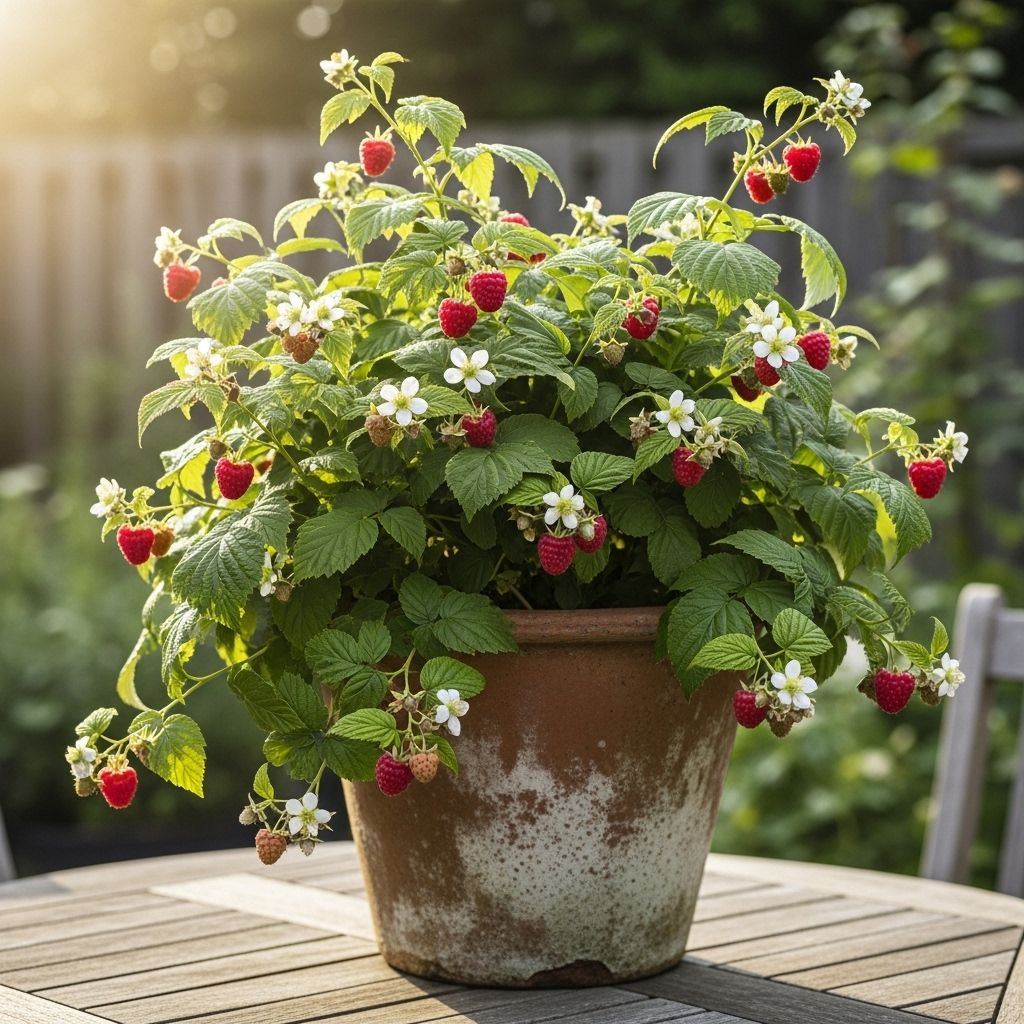The Complete Guide to Growing Raspberries in Containers
Smart supports and easy soil blends yield juicy fruit, even in the tiniest outdoor nooks.

Growing Raspberries in Containers: The Essential Guide
Raspberries are beloved for their juicy, tangy-sweet berries and their capacity to thrive even in small gardens. Growing them in containers offers gardeners the flexibility to cultivate delicious fruit on patios, balconies, or cramped urban plots. This comprehensive guide covers every aspect of container raspberry cultivation, including variety selection, container prep, soil needs, care practices, troubleshooting, and frequently asked questions.
Why Grow Raspberries in Containers?
- Space efficiency: Containers let you grow berries even in limited areas like balconies or patios.
- Mobility: Move your plants to shield them from harsh weather or optimize sun exposure.
- Pest and disease control: Elevating raspberries can reduce exposure to soil-borne pathogens and improve monitoring.
- Soil control: Easily optimize pH, drainage, and fertility for healthy plant growth.
Best Raspberry Varieties for Containers
Not all raspberry cultivars perform equally well in pots. Selecting the right type enhances vigor and simplifies care. Recommended varieties include:
- ‘Raspberry Shortcake’: Dwarf size, thornless canes, and ideal for small containers.
- ‘Heritage’: Primocane, fall-bearing, container-tolerant.
- ‘Polka’: Compact, high yields, reliable flavor.
- ‘Golden Anne’: Unique yellow berries and compact growth.
Choose primocane (fall-bearing) types if you want fewer support concerns and harvests from both first- and second-year canes. In contrast, floricane (summer-bearing) types generally need more staking but offer bigger yields in a condensed season.
How to Prepare Containers for Raspberries
Container Size and Material
- Minimum size: 16-inch diameter, 16-inch depth for each cane. Larger containers (such as half-barrels) support multiple canes.
- Material options: Sturdy plastic, glazed ceramic, wooden planters. Fabric grow bags drain well but can dry out more rapidly.
- Drainage is mandatory: Ensure at least 8-9 holes at the base or use breathable fabric containers. Never plant in pots without sufficient drainage.
| Container Type | Pros | Cons |
|---|---|---|
| Plastic Pot | Retention of moisture, good durability, easy to drill holes | Can heat up quickly in sun |
| Wooden Planter | Traditional look, natural insulation | Heavy, may rot over time |
| Fabric Grow Bag | Excellent drainage, lightweight | Prone to rapid drying, less stable |
Supporting Raspberry Canes
- Summer-bearing varieties require support due to taller, heavier canes.
- Common support options:
- Tomato cages (fit round containers)
- Stakes around container perimeter tied with twine at intervals
- Small trellises placed in the pot
Soil Requirements for Container Raspberries
Container gardening enables precise control over soil composition, vital for healthy raspberry growth. Optimal characteristics include:
- pH level: Slightly acidic (6.0–6.2 preferred). Avoid soils below pH 5.8 or above pH 6.5.
- Structure: Loamy, rich in organic matter, and free-draining. Heavy clay or soggy mixes risk root rot.
- Moisture retention: Should retain water but never become waterlogged.
To create optimal raspberry soil:
- Start with high-quality bagged potting soil.
- Amend with:
- Compost (nutrition)
- Aged manure (nutrition and acidity)
- Peat moss (acidity and moisture retention)
- Pine needles or composted leaf mold (slight acidifying effect)
- Perlite or coarse sand (better drainage)
If available, select a mix formulated for acid-loving plants.
Fertilizers and Nutrient Management
- Balanced NPK fertilizer (10-10-10 or 8-8-8) applied in spring aids growth.
- Organic amendments (compost, worm castings) add micronutrients and beneficial microbes.
- Supplement potassium and magnesium if deficiencies appear (yellowing leaves).
Mulching Your Container Raspberries
- Apply a 1-inch layer of coarse bark or woody mulch after planting.
- Promotes moisture retention and mimics natural forest floor, reducing weeds.
- Avoid fine straw or soft mulch that can trap excessive moisture and foster disease.
Planting Raspberries in Containers: Step-by-Step
- Prepare the Pot: Ensure drainage holes. Place a layer of gravel or coarse bark at the base if desired.
- Mix Soil: Combine potting mix, peat, compost, and sand/perlite.
- Plant: Set cane in pot, centering the root ball. Fill with soil to just at the root crown, ensuring no buried stems.
- Water: Saturate the soil until water drains out the bottom. Add mulch.
- Set Up Supports: Install cage, stakes, or twine as needed.
Location and Sunlight Requirements
- Sunlight: At least 6–8 hours of direct sun daily for strong fruit set.
- Avoid excessive shade, especially during the fruiting season.
- Protection from wind: Shelter containers behind barriers or close to buildings; windy spots can dry roots.
- In hot climates, afternoon shade may help prevent overheating.
Watering and Moisture Management
- Water consistently: Containers evaporate faster, so check moisture daily in peak summer.
- Irrigate as soon as the top inch feels dry, especially during bloom and fruit set.
- Drip irrigation or soaker hoses can be installed for large collections.
- Avoid standing water or waterlogged soil, which causes rot.
Ongoing Care: Pruning and Training
- Prune container raspberries annually to remove spent canes after fruiting or in early spring.
- Floricane types: Cut fruited canes to soil level after harvest; leave new canes for next year.
- Primocane types: Cut all canes to base in late winter for manageable growth and simplified harvest.
- Thin out weak, crossing, or diseased stems throughout the season for best airflow.
- Regularly check supports and retie as needed to prevent wind damage.
Fertilizing Container Raspberries
- Spring: Apply balanced fertilizer just as buds swell.
- Early Summer: Repeat with a light application after first harvest.
- Organic approach: Top-dress with compost or worm castings instead of synthetic fertilizer for sustainable nutrition.
Harvesting Raspberries Grown in Containers
- Pick ripe berries every few days for 2–4 weeks during the harvest window.
- Gentle handling: Raspberries bruise easily; use shallow trays to collect fruit.
- Early morning harvest preserves flavor and extends freshness.
- Remove overripe or fallen fruit promptly to prevent pests.
Common Challenges and Troubleshooting for Container Raspberries
Disease and Pest Issues
- Root rot: Results from overwatering or poor drainage; always check for soggy soil.
- Spider mites: Dusty leaves and webbing can mean dry air or stress—spray plants and increase humidity.
- Aphids and cane borers: Monitor leaves for curling or discolored patches; treat with insecticidal soap if needed.
- Powdery mildew: White film on leaves; improve airflow and reduce overhead watering.
Environmental Problems
- Drying out: Fast evaporation in summer; routine mulching and frequent watering help.
- Heat stress: Move pots away from strong afternoon sun or provide shading.
- Nutrient depletion: Container soils exhaust faster; regular top-dressing or a slow-release fertilizer prevent deficiency symptoms.
Frequently Asked Questions (FAQs)
Q: Can raspberry plants survive winter in containers?
A: Yes, with protection. Insulate pots by wrapping with burlap or bubble wrap, and move them to sheltered spots. In colder zones, roots may suffer unless containers are large or plants are moved indoors.
Q: How many canes can I plant in one container?
A: For 16-inch pots, one cane is best; half-barrels can fit three to four canes. Overcrowding increases stress and disease risk.
Q: How long does it take to harvest fruit?
A: Most raspberries fruit in their second year. Some primocane (fall-bearing) types may produce a short crop in year one.
Q: Do I need to repot container raspberries?
A: Yes, every 2–3 years. Fresh soil and more room for root growth will boost health and yields.
Q: Can I propagate raspberries from containers?
A: Yes. Take root cuttings from healthy plants in winter, or divide excess suckers and replant them in fresh containers.
Pro Tips for Successful Container Raspberry Growing
- Rotate crops: Don’t reuse soil for more than 1–2 seasons to limit disease risk.
- Monitor soil pH: Test regularly. Amend with peat moss or sulfur if pH creeps above 6.5.
- Use rainwater: If your tap water is alkaline, rainwater helps maintain acidity.
- Plan succession: Rejuvenate older plants by dividing and replanting canes every 2–3 years.
Conclusion: Experience Bountiful Berries in Any Space
Container-grown raspberries are an excellent choice for anyone seeking delicious homegrown fruit in confined garden areas. With careful selection of containers and soil, consistent watering and feeding, and diligent pruning, you will enjoy healthy plants and vibrant harvests every season. From sunny balconies to north-facing patios, raspberries can thrive where other fruits struggle.
References
Read full bio of Shinta












